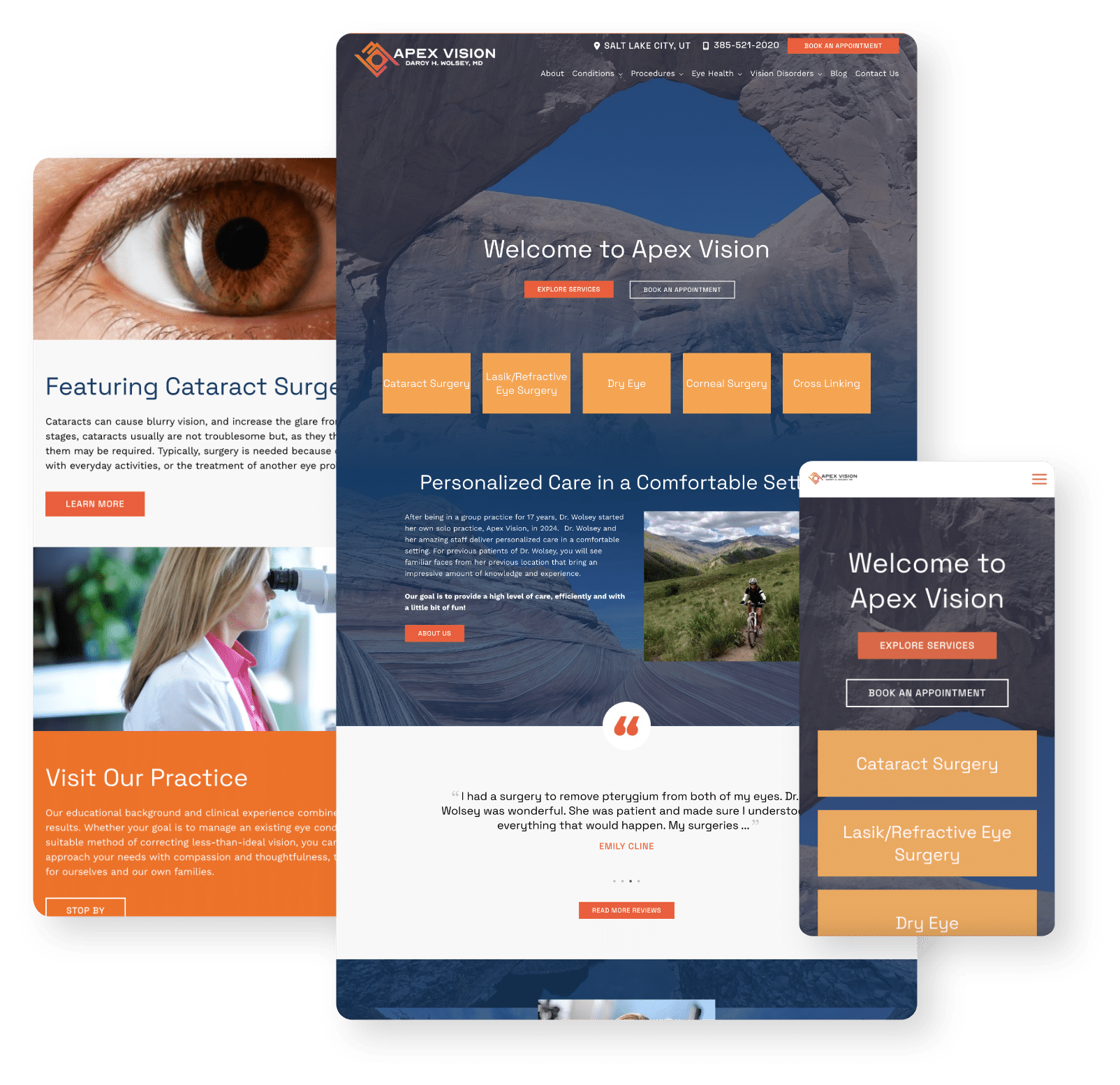
How to Know If Your Ophthalmology Website Design Is Good
In the field of ophthalmology, what distinguishes an ophthalmology website and defines its quality in design? The essence of a well-designed ophthalmology website includes four main things.
Four Characteristic Features of a Good Ophthalmology Website
1 |
It looks great — and functions beautifully.

In today’s ophthalmology landscape, the significance of your website extends far beyond the aesthetic appeal.
While it definitely matters what your ophthalmology website looks like, that’s merely the tip of the iceberg when it comes to establishing a robust online presence. In today's digital age, where a multitude of devices and browsers are utilized to access the vast expanse of the Internet, the concept of responsive web design takes center stage.
Responsive design isn't just a buzzword; it's an indispensable facet of any ophthalmology website seeking to thrive in the dynamic digital ecosystem. The essence of responsive design lies in its ability to seamlessly adapt to the diverse range of browser-device combinations that users employ. This adaptability is the key to delivering an optimal user experience.
The importance of mastering responsive design cannot be overstated. Failing to do so can result in a plethora of issues that are detrimental to your website's performance and, by extension, your practice. A website that is not responsive may render poorly on certain devices or browsers, causing content to appear distorted or functionality to break down. Such inadequacies can be a source of immense frustration for your visitors, ultimately driving them away in search of more user-friendly alternatives.
Conversely, a website that excels in responsive design fosters a harmonious experience for your audience, regardless of the device they use to access it. It ensures that content is presented flawlessly, navigation is intuitive, and all interactive elements function smoothly. This impeccable user experience is not only satisfying for your current patients but also serves as a powerful magnet for potential clients and business prospects.
By prioritizing responsive design in your ophthalmology website, you not only thwart user frustration but also extend a warm welcome to an expanding pool of patients and future business opportunities. It's a critical investment in the longevity and success of your online presence, affirming your commitment to delivering top-tier eye care services in the digital age.
2 |
It’s accessible to everyone.
Ensuring that all users, including those with disabilities, have unfettered access to your website is a non-negotiable imperative. To achieve this, it is essential for your website to conform to the rigorous standards set forth by the Americans With Disabilities Act (ADA). These standards are not just guidelines; they are legally mandated to guarantee that individuals with disabilities are not unjustly excluded from the digital realm. Non-compliance with these ADA standards can have far-reaching consequences, and they extend beyond monetary penalties.
The repercussions of non-compliance with ADA guidelines are substantial and multifaceted. On a financial front, the penalties for the first offense can be staggering, ranging from $55,000 to $75,000. These fines can be a substantial burden for any business, and they underscore the seriousness with which regulatory authorities view digital accessibility. Legal actions may also ensue, which can result in protracted legal battles, further increasing the financial strain on your organization.
However, the consequences of non-compliance extend beyond the immediate financial impact. Failing to make your website accessible limits access to the vast community of nearly 1.4 billion individuals with disabilities worldwide. This exclusion is not just a matter of numbers; it represents a significant social and ethical concern. It means that a substantial portion of the global population is denied equal access to the information and services available on your website, hindering their participation in various aspects of life, including education, employment, and social interaction.
Furthermore, search engines have started to prioritize accessible websites in their rankings. Search engines, as gatekeepers to the digital realm, now favor websites that are accessible to all users. Non-compliance with accessibility standards can lead to penalties in terms of your website's visibility and ranking, potentially reducing its reach and impact.
Therefore, it is clear that prioritizing accessibility is not just a matter of legal compliance but also an ethical responsibility and a practical necessity for any business or organization operating in the digital sphere. It is a commitment to inclusivity, a safeguard against financial penalties, and a strategic move to enhance your online presence in a rapidly evolving digital landscape.
Ensuring that all users, including those with disabilities, have unfettered access to your website is a non-negotiable imperative. To achieve this, it is essential for your website to conform to the rigorous standards set forth by the Americans With Disabilities Act (ADA). These standards are not just guidelines; they are legally mandated to guarantee that individuals with disabilities are not unjustly excluded from the digital realm. Non-compliance with these ADA standards can have far-reaching consequences, and they extend beyond monetary penalties.
The repercussions of non-compliance with ADA guidelines are substantial and multifaceted. On a financial front, the penalties for the first offense can be staggering, ranging from $55,000 to $75,000. These fines can be a substantial burden for any business, and they underscore the seriousness with which regulatory authorities view digital accessibility. Legal actions may also ensue, which can result in protracted legal battles, further increasing the financial strain on your organization.
However, the consequences of non-compliance extend beyond the immediate financial impact. Failing to make your website accessible limits access to the vast community of nearly 1.4 billion individuals with disabilities worldwide. This exclusion is not just a matter of numbers; it represents a significant social and ethical concern. It means that a substantial portion of the global population is denied equal access to the information and services available on your website, hindering their participation in various aspects of life, including education, employment, and social interaction.
Furthermore, search engines have started to prioritize accessible websites in their rankings. Search engines, as gatekeepers to the digital realm, now favor websites that are accessible to all users. Non-compliance with accessibility standards can lead to penalties in terms of your website's visibility and ranking, potentially reducing its reach and impact.
Therefore, it is clear that prioritizing accessibility is not just a matter of legal compliance but also an ethical responsibility and a practical necessity for any business or organization operating in the digital sphere. It is a commitment to inclusivity, a safeguard against financial penalties, and a strategic move to enhance your online presence in a rapidly evolving digital landscape.
3 |
It protects patient information.

In the digital age, the importance of safeguarding healthcare-related data cannot be overstated, particularly when it comes to protected health information (PHI). Compliance with the stringent standards set forth by the Health Insurance Portability and Accountability Act (HIPAA) is an absolute necessity.
However, this imperative extends beyond your medical practice and employees; it encompasses every facet of your online presence, including your website's hosting provider. In fact, hosting providers play a pivotal role in ensuring that your entire digital ecosystem is fully HIPAA compliant.
The multifaceted nature of HIPAA compliance underscores the depth of commitment required to protect PHI. It goes beyond merely securing data within the confines of your practice; it mandates a comprehensive approach to data security. This means that your hosting provider must adhere to the same rigorous HIPAA standards to guarantee that the PHI stored or processed on your website remains confidential and secure. Failing to do so can result in grave consequences, including legal ramifications, fines, and damage to your practice's reputation.
The importance of prioritizing security transcends the storage of PHI alone. Even if your website does not directly store this sensitive information, there are other critical security measures that must be in place to protect against potential vulnerabilities. One of the fundamental steps is the implementation of SSL encryption, which is denoted by URLs starting with HTTPS. SSL (Secure Sockets Layer) encryption is the backbone of secure data transmission on the web. It not only ensures that data is transmitted between the user's browser and your website securely but also validates the authenticity of your website.
Maintaining up-to-date SSL certificates is crucial in averting security vulnerabilities. These certificates provide a level of trust to your website visitors, assuring them that their data is being transmitted securely. An outdated or expired certificate can trigger browser warnings, eroding user trust and potentially driving them away from your website.
Furthermore, search engines have taken a keen interest in promoting secure web practices. Google, for instance, has incorporated SSL encryption as a ranking factor, giving preference to websites that employ HTTPS in their search results. This means that non-compliance with security measures like SSL encryption can result in penalties from search engines, reducing the visibility and reach of your website.
In essence, whether you are handling PHI directly or not, the security of your healthcare website is of paramount importance. It is an integral part of your commitment to patient privacy, legal compliance, and maintaining a strong online presence. By ensuring HIPAA compliance and employing robust security practices, you not only protect sensitive data but also bolster the trust of your patients and website visitors, ultimately enhancing your digital reputation and safeguarding the future of your practice.
4 |
It turns visitors into patients.
When assessing the effectiveness of your website, the pivotal metric to keep a close eye on is the conversion rate. This metric serves as a litmus test, revealing the proportion of your website visitors who take the crucial step of becoming your patients. While what constitutes a "good" conversion rate can vary among different industries, ophthalmology websites typically set their sights on achieving a conversion rate of around 3%. If your conversion rate falls short of this mark, it's an indicator that it may be time to contemplate a website redesign or to conduct a thorough examination of your conversion elements.
These conversion elements encompass a range of interactive features designed to stimulate user engagement. These features include, but are not limited to, click-to-call buttons, user-friendly forms, live chat widgets, and easily accessible contact pages. They act as the catalysts for converting curious visitors into loyal patients. However, the effectiveness of these elements can be influenced by various factors, such as functionality issues, display inconsistencies, or incorrect placement on your website. It's crucial to address these issues promptly to optimize your conversion rates.
In essence, to make a significant impact in the highly competitive field of ophthalmology and craft an exceptional ophthalmology website, it's essential to strike a harmonious balance among several key components. These include an aesthetically pleasing design, adherence to accessibility standards, robust security measures, and, last but not least, a high conversion rate. This multifaceted approach is the bedrock of success, ensuring that your website not only attracts but also effectively converts visitors into valued patients.
When assessing the effectiveness of your website, the pivotal metric to keep a close eye on is the conversion rate. This metric serves as a litmus test, revealing the proportion of your website visitors who take the crucial step of becoming your patients. While what constitutes a "good" conversion rate can vary among different industries, ophthalmology websites typically set their sights on achieving a conversion rate of around 3%. If your conversion rate falls short of this mark, it's an indicator that it may be time to contemplate a website redesign or to conduct a thorough examination of your conversion elements.
These conversion elements encompass a range of interactive features designed to stimulate user engagement. These features include, but are not limited to, click-to-call buttons, user-friendly forms, live chat widgets, and easily accessible contact pages. They act as the catalysts for converting curious visitors into loyal patients. However, the effectiveness of these elements can be influenced by various factors, such as functionality issues, display inconsistencies, or incorrect placement on your website. It's crucial to address these issues promptly to optimize your conversion rates.
In essence, to make a significant impact in the highly competitive field of ophthalmology and craft an exceptional ophthalmology website, it's essential to strike a harmonious balance among several key components. These include an aesthetically pleasing design, adherence to accessibility standards, robust security measures, and, last but not least, a high conversion rate. This multifaceted approach is the bedrock of success, ensuring that your website not only attracts but also effectively converts visitors into valued patients.
Curious how your website stacks up against your competition?
We built a tool for that. Enter your website address and we’ll send you a custom report.


